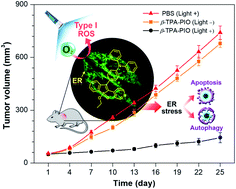当前位置:
X-MOL 学术
›
Chem. Sci.
›
论文详情
Our official English website, www.x-mol.net, welcomes your
feedback! (Note: you will need to create a separate account there.)
Type I photosensitizers based on phosphindole oxide for photodynamic therapy: apoptosis and autophagy induced by endoplasmic reticulum stress
Chemical Science ( IF 7.6 ) Pub Date : 2020/03/02 , DOI: 10.1039/d0sc00785d Zeyan Zhuang 1 , Jun Dai 2 , Maoxing Yu 1 , Jianqing Li 1 , Pingchuan Shen 1 , Rong Hu 1 , Xiaoding Lou 3 , Zujin Zhao 1 , Ben Zhong Tang 1, 4
Chemical Science ( IF 7.6 ) Pub Date : 2020/03/02 , DOI: 10.1039/d0sc00785d Zeyan Zhuang 1 , Jun Dai 2 , Maoxing Yu 1 , Jianqing Li 1 , Pingchuan Shen 1 , Rong Hu 1 , Xiaoding Lou 3 , Zujin Zhao 1 , Ben Zhong Tang 1, 4
Affiliation

|
Photodynamic therapy (PDT) is considered a pioneering and effective modality for cancer treatment, but it is still facing challenges of hypoxic tumors. Recently, Type I PDT, as an effective strategy to address this issue, has drawn considerable attention. Few reports are available on the capability for Type I reactive oxygen species (ROS) generation of purely organic photosensitizers (PSs). Herein, we report two new Type I PSs, α-TPA-PIO and β-TPA-PIO, from phosphindole oxide-based isomers with efficient Type I ROS generation abilities. A detailed study on photophysical and photochemical mechanisms is conducted to shed light on the molecular design of PSs based on the Type I mechanism. The in vitro results demonstrate that these two PSs can selectively accumulate in a neutral lipid region, particularly in the endoplasmic reticulum (ER), of cells and efficiently induce ER-stress mediated apoptosis and autophagy in PDT. In vivo models indicate that β-TPA-PIO successfully achieves remarkable tumor ablation. The ROS-based ER stress triggered by β-TPA-PIO-mediated PDT has high potential as a precursor of the immunostimulatory effect for immunotherapy. This work presents a comprehensive protocol for Type I-based purely organic PSs and highlights the significance of considering the working mechanism in the design of PSs for the optimization of cancer treatment protocols.
中文翻译:

基于氧化膦的 I 型光敏剂用于光动力治疗:内质网应激诱导的细胞凋亡和自噬
光动力疗法(PDT)被认为是癌症治疗的先驱和有效方式,但它仍然面临着缺氧肿瘤的挑战。最近,I 型 PDT 作为解决这一问题的有效策略引起了广泛关注。关于纯有机光敏剂 (PS) 的 I 型活性氧 (ROS) 生成能力的报告很少。在此,我们报告了两种新的 I 型 PS,α -TPA-PIO 和β -TPA-PIO,它们来自基于氧化膦的异构体,具有有效的 I 型 ROS 生成能力。对光物理和光化学机制进行了详细研究,以阐明基于 I 型机制的 PS 的分子设计。在体外结果表明,这两种 PS 可以选择性地积聚在细胞的中性脂质区域,特别是在内质网 (ER) 中,并在 PDT 中有效诱导 ER 应激介导的细胞凋亡和自噬。体内模型表明,β -TPA-PIO 成功地实现了显着的肿瘤消融。由β -TPA-PIO 介导的 PDT触发的基于 ROS 的 ER 应激作为免疫治疗的免疫刺激作用的前体具有很高的潜力。这项工作提出了基于 I 型的纯有机 PS 的综合方案,并强调了在 PS 设计中考虑工作机制以优化癌症治疗方案的重要性。
更新日期:2020-04-01
中文翻译:

基于氧化膦的 I 型光敏剂用于光动力治疗:内质网应激诱导的细胞凋亡和自噬
光动力疗法(PDT)被认为是癌症治疗的先驱和有效方式,但它仍然面临着缺氧肿瘤的挑战。最近,I 型 PDT 作为解决这一问题的有效策略引起了广泛关注。关于纯有机光敏剂 (PS) 的 I 型活性氧 (ROS) 生成能力的报告很少。在此,我们报告了两种新的 I 型 PS,α -TPA-PIO 和β -TPA-PIO,它们来自基于氧化膦的异构体,具有有效的 I 型 ROS 生成能力。对光物理和光化学机制进行了详细研究,以阐明基于 I 型机制的 PS 的分子设计。在体外结果表明,这两种 PS 可以选择性地积聚在细胞的中性脂质区域,特别是在内质网 (ER) 中,并在 PDT 中有效诱导 ER 应激介导的细胞凋亡和自噬。体内模型表明,β -TPA-PIO 成功地实现了显着的肿瘤消融。由β -TPA-PIO 介导的 PDT触发的基于 ROS 的 ER 应激作为免疫治疗的免疫刺激作用的前体具有很高的潜力。这项工作提出了基于 I 型的纯有机 PS 的综合方案,并强调了在 PS 设计中考虑工作机制以优化癌症治疗方案的重要性。











































 京公网安备 11010802027423号
京公网安备 11010802027423号